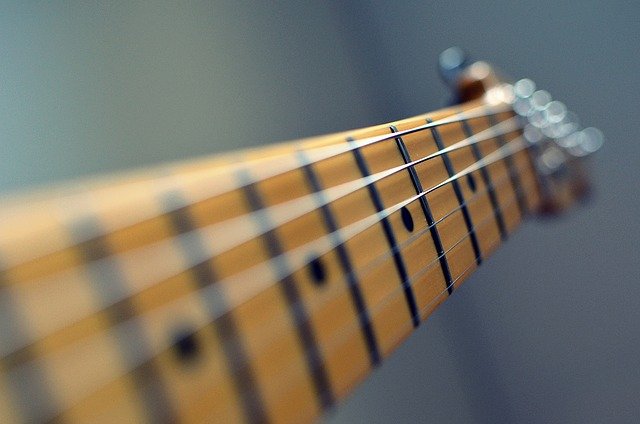
There are ways to learn all of the notes on the guitar fretboard
There are many techniques you can use to find the notes on the guitar fretboard. I’ve talked about some of these techniques in various articles including A Simple Pattern Can Help You Learn the Notes on a Guitar and How to Easily Learn the Notes on the E String. These techniques are very helpful when you’re learning the notes on the guitar fretboard.
But you can play guitar for years and still miss an interesting fact about the guitar. I know this because I missed this fact for, oh, somewhere around 40 years of playing.
So, clearly, this fact isn’t exactly critical to learning to play the guitar. But in addition to being interesting, it can open your mind to a new way of thinking about your instrument.
No matter where you put your finger, all of the notes on the guitar fretboard are nearby
So what is this interesting fact about the notes on the guitar fretboard? Simply this: no matter where you put your index finger on the fretboard, every note is available to you somewhere across the six strings and four frets starting with the one your finger is on.
In other words, no matter where you put your hand, you are always within easy reach of every note. You don’t even have to change your hand position. Most of us have four fingers available to easily play a range of four frets, and if you do that across all six strings, you will have played every possible note.
Start with the Low E string
Really? Well, let’s try it to see for yourself. Press down at the fifth fret of the Low E string. You know (from the articles mentioned above) that this is the note A.
Now, climb up the E string one fret at a time and play the notes you find. At fret 6 you have A#/Bb, at fret 7 you have B, at fret 8 you have C. And now you’re out of fingers.
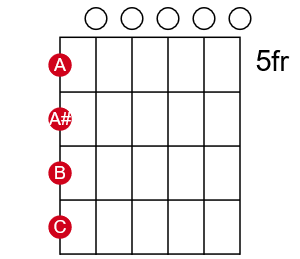
Next the notes on the A string
So, move up to the A string with your index finger staying at the fifth fret. Here you have the note D. Oops! I must have been wrong, because we didn’t get a C#/Db.
Well, I didn’t say each note is available in a chromatic fashion on those four frets. I just promised that each note would be available. Be patient…you’ll see that the C#/Db is coming.
For now, let’s carry on. D is at fret 5 of the A string, D#/Eb at fret 6, E at fret 7, and F at fret 8.
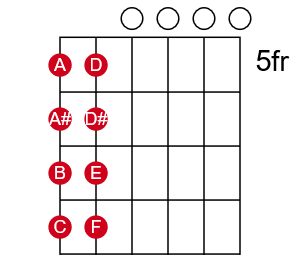
So, you see, we’re making steady progress through the notes on the guitar fretboard. But we’re not done yet.
The notes on the D string
You’ve run out of fingers again, so move up to fret 5 of the D string. Here’s the note G. So, you see we’ve missed another note–the F#. Don’t worry; we’ll get there.
Next finger up is G#/Ab, then one more fret up takes you to A at the seventh fret.
Remember, we started at A back at the Low E string on fret 5, so we’ve gone an entire octave. But we’re still missing those two notes–C#/Db and F, so let’s keep going.
Put your pinky down at fret 8 for the note A#.
Now you see that we’re starting to repeat notes. I said you’d find all of the notes within these four frets, but I neglected to mention that you’ll find many of them more than once. It’s like this for all notes on the guitar fretboard.
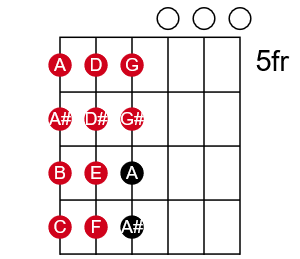
The notes on the G string
We still have to find those two missing notes, so keep going. Since you’re out of fingers again, move to fret 5 of the G string. Here’s the note C. Notice, we’ve missed the B in this pass.
One fret up is C#/Db. There’s one of our missing notes!
Up one fret to fret 7 we have another D, and D#/Eb at fret 8.
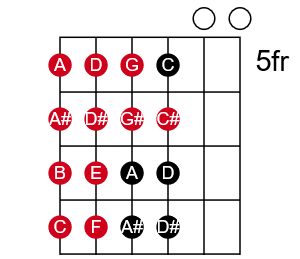
The notes on the B string
Next, up to fret 5 on the B string, and that’s the note E. Up one fret to F, and up another to fret 7 on the B string, and that’s the other of our missing notes, the F#. And now all of the notes have been accounted for.
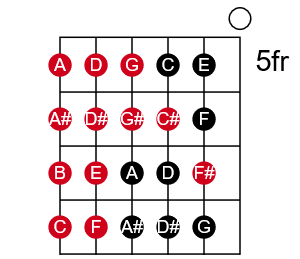
The notes on the High E string
Of course, you can keep climbing to the E string where you’ll find the same notes as you found on the low E string. That is, starting at fret 5 you have A, A#/Bb, B, and C.
So, you’ve now climbed all the way up from the Low E, fret 5 to the High E fret 8. And you’ve seen that indeed you did play every note at least once, as marked in red in this image.
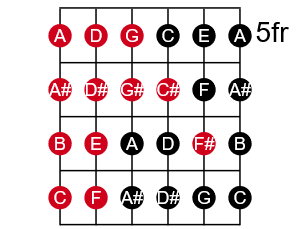
No matter what fret you start at, you can find all of the notes on the guitar fretboard nearby
And this works everywhere, for all notes on the guitar fretboard. I don’t have to walk you through it, but you can experiment for yourself to prove that it doesn’t matter what fret you start on. Any time you play four consecutive frets across all six strings, you will eventually play every note at least once.
Here’s the result of starting at fret 10. Notice that the pattern of red notes is exactly the same no matter what fret you start at, and that again, all notes are found within the four-fret range.
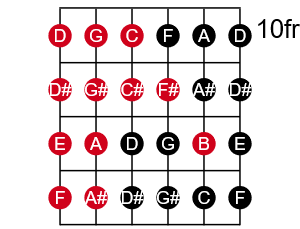
Use a five-fret range to play the entire chromatic scale
OK; so what? This is more than just a neat parlor trick. The implications of this knowledge run straight to some pieces of important understanding about your instrument.
For instance, you might have made another interesting realization during this exercise we’ve just run through. Every time there’s a “missing” note, it exists just one fret below the starting fret. That means that if you’re willing to work just a little bit harder, you can easily play the entire chromatic scale no mater where you start on the fretboard.
Take the D note at fret 10 of the Low E string again as the starting position. Move up four frets consecutively just like you did a moment ago until you’re at the note F on the eighth fret.
But this time, instead of moving over to the A string at fret 10, reach back one fret with your pointer to fret 9 of the D string. This is the F#/Gb that your were missing before.
Slide your pinky up to fret 10 and continue on as before. Next, reach back to fret 9 on the D string and you’ll get that B that was missing earlier.
Fret 9 on the G string gets you the E note that you skipped before.
Because the B string always causes things to be weird, there’s no need to reach back to fret 9 when you move to the B string.
Finally, reach back to fret 9 to grab the C# on the E string.
Now you’ve got an easy map to follow in order to play the entire chromatic scale across all six strings in a five-fret range.
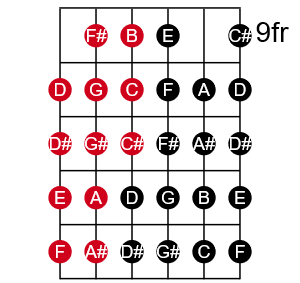
Major scales are everywhere too
And, since we know that the chromatic scale holds within it the major scale (and, of course, any other scale), then we can extrapolate to realize that no matter where we are on the fretboard, we can find the major scale in any key. Now there’s some power in that statement.
If you know that you can find a major scale anywhere, then you instantly expand your understanding and playing possibilities.
And it’s worth saying again: this works for all notes on the guitar fretboard. No matter where you put your hand, you are instantly within reach of all 12 chromatic notes. And you are instantly within reach of all 12 major scales.
Implications for chords too
Not only that, but you now understand that all of the notes you need to make any chord on the guitar are everywhere on the guitar. As we explore chords more in future articles, you’ll really begin to see the power of knowing that you can find the notes you need to make any chord no matter where you’re hand is on the fretboard.
Just like the notes on the guitar fretboard are literally everywhere on the fretboard, all chords you can possibly imagine are also to be found literally everywhere on the fretboard.
Don’t let this overwhelm you. If all this talk about chords and scales is getting confusing, take a look at my articles Understanding the Major Scale is Foundational Music Theory and It’s Easier Than You Think to Learn How to Play a Chord on Guitar.
Conclusion
In your quest to better understand the guitar, it’s helpful to know some useful techniques for learning the notes on the guitar fretboard.
One interesting–and often overlooked–characteristic of the guitar makes it possible to play all 12 notes within a four-fret span across all six strings. And if you expand to a five-fret range, you can play the entire chromatic scale no matter where your hand lands on the instrument.
Aside from being a cool thing even experienced players overlook for years, this knowledge holds great implication for finding the note you want, playing the major scale in any key no matter where on the neck you are, and finding a form of any possible chord everywhere on the neck.
Mastering the notes on the guitar fretboard can–and often does for beginners and experience players alike–seem overwhelming and a bit daunting.
Helping you to be more comfortable with your instrument by demystifying the notes on the guitar fretboard may be the biggest benefit of all to this “hidden” characteristic of the guitar!
8 comments